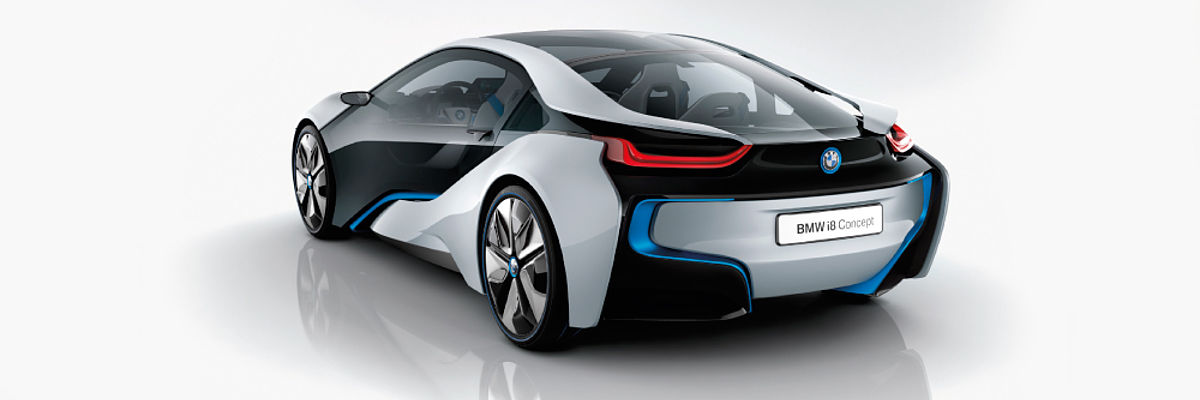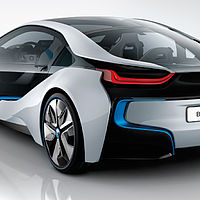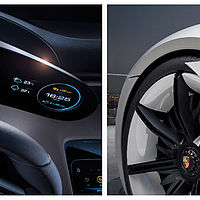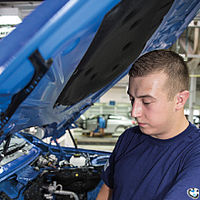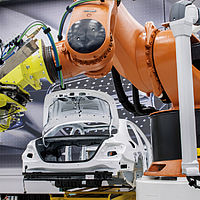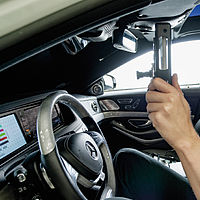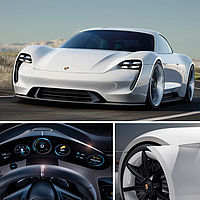Smart Factory with networked value chain
While automobile producers vie for the best drive solution of the future, the concerns are transforming from manufacturers into mobility service providers.
The future has already begun: along with battery-powered electric vehicles, hydrogen engines are vying to become the best drive solution of the future. While the transition phase is marked by hybrid cars, advanced digitalisation is transforming automakers into mobility service providers.
With the development of the urban mobility concept BMW i for sustainable and future-oriented mobility as well as the eDrive architecture and the new EfficientDynamics engine family, the Bavarian manufacturer feels perfectly equipped to meet the challenges of the future. Among all of the German manufacturers, BMW has positioned itself most clearly in terms of electrification, even having launched its own product line. The BMW i3 is currently the only pure electric vehicle. At its side is the i8 model. As a plug-in hybrid, the sports car combines an electric motor with an internal combustion engine. In parallel to this, for the drive of the future, Bayerische Motoren Werke is placing its bets on a promising collaboration.
"Together with our partner Toyota, we are well on our way to developing hydrogen fuel cell technology for implementation in series production by 2020"
says Marcus Bollig, Head of EfficientDynamics at BMW, clearly indicating the line of approach.
Daimler AG is also charting a course similar to the one BMW has set. For more than 20 years now, the company has been investing in research into the fuel-cell-driven electric car. That commitment has yet to lead to a series production vehicle, however. Instead the Tesla holding cleared the way for two series production cars. Although the electric Smart is no longer marketed, the electric variant of the Mercedes B-Class is still available. Daimler also offers two natural gas vehicles, six electric hybrids and three plug-in hybrids.
In the race to achieve a breakthrough in new environmentally sound drive technologies, Porsche is another strong competitor. In keeping with the company motto "Where the future has a long tradition", Matthias Müller, current CEO of Volkswagen and former head of Porsche, considers high-tech racing as a development tool.
"There really are enough examples of innovations which have made it from the racetrack to series production. The most recent one is the plug-in hybrid"
, says Müller, referring to the Zuffenhausen-based sports car manufacturer’s commitment to the World Endurance Championship (WEC). In its second year, Porsche "cleaned up" with the 919 Hybrid, not only at the FIA World Endurance Championship, but also at the venerable 24 Hours of Le Mans. Müller adds:
"The WEC, with its largely open hybrid regulations and long endurance race distances, is an ideal development field for future drives"
. Porsche is convinced about the bridge technology, which
"might prove to be even more than that over the long term"
. In December 2015, Porsche also gave the green light for the series production of the Mission E. With 600 hp system horsepower, acceleration from 0 to 100 km/h in 3.5 seconds and a range of more than 500 kilometres, Porsche wants to challenge the electric giant Tesla. Part of the development work is a rapid charging system based on an 800-volt charging unit. Plans call for charging 80% of the range in just 15 minutes.
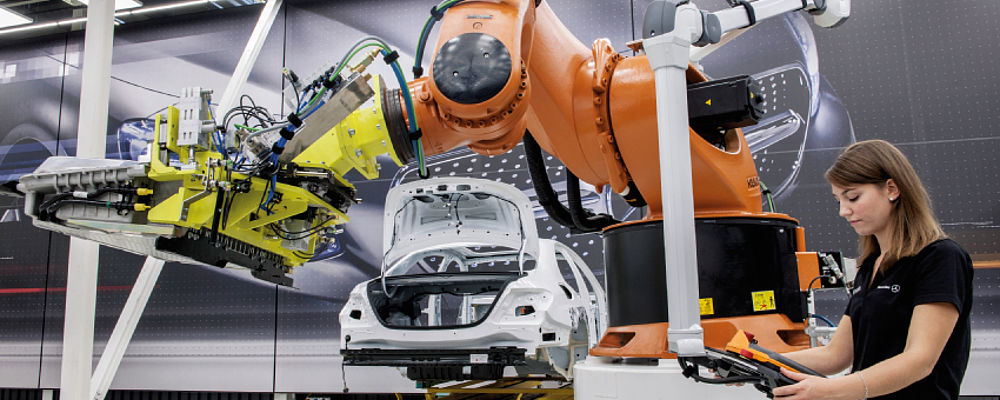
More technologies alongside one another in future
Ford is offering its customers an electric Focus and a hybrid Mondeo. Opel interprets the increased efficiency of its vehicles more in the here and now. The Rüsselsheim-based company has added efficient, small cars like the Adam and the Karl to its range. Opel does not market any electric vehicles. The production of the plug-in hybrid Ampera is being phased out. Instead, most models are offered with liquefied petroleum gas (LPG) engines. Volkswagen offers the widest range of models: with its e-up and e-Golf models, the Wolfsburg-based group has two battery-powered electric cars. Those electrics are flanked by three plug-in hybrids on the Golf and Passat platforms. With the Audi A3 e-tron, the sister company offers a plug-in hybrid model that is technically identical to the Golf GTE in most respects.
It still remains to be seen which drive concept will prevail. At BMW, strategists assume that along with classic internal-combustion-engine-powered vehicles, small- to medium-sized battery-powered electric vehicles and so-called plug-in hybrids will be needed in the medium term. The problem of how to achieve longer ranges for travel and long-distance driving could be solved by hydrogen-fuel-cell-powered electric vehicles.
"But no near-term solution is expected"
, reports Manfred Poschenrieder, Spokesperson Innovation and Technology at BMW. The break-even point for hydrogen fuel cell-powered vehicles will be reached when the technology achieves ranges of 300 to 400 kilometres. Then the fuel cells will have a chance to become less expensive than battery-powered electric vehicles.
Intelligent production processes and effective energy management
Operating different drive technologies alongside one another is the sort of change in conditions that does not leave production processes unaffected. With their model series 3 and 8, for example, BMW has already turned completely away from the use of conventional materials for body construction. The chassis is made of aluminium (drive module), and the passenger compartment (life module) is made of carbon-fibre-reinforced plastic (CFRP). Together with optimised parts logistics, a new family of internal combustion engines is enabling efficient production conditions for manufacturing classically powered cars through the assembly of three-, four- and six-cylinder engines on a single production line.
All plug-in hybrid manufacturers are looking for the most efficient operating strategy in order to achieve the ideal combination of internal combustion engine and e-motor. Daimler adapts the energy management system in the new Mercedes S 500 plug-in hybrid not only to the charge level of the battery, but also to the traffic and the route. Drivers can also take control of the situation for themselves if they so wish. A haptic accelerator pedal gives the driver feedback about the shift point of the internal combustion engine and signals with a double tap when they should take their foot off the accelerator for recuperation. BMW is taking a similar approach. They share an overarching objective: to combine the two types of drives in the most efficient way possible and to minimise fuel consumption. That’s why the BMW 3 eDrive favours electric operation in urban traffic and other low-speed areas, taking full advantage of the zero-emission drive. At higher speeds and during rapid acceleration, the internal combustion engine kicks in. A so-called ‘boost function’ makes it possible to superpose the torques delivered by the two drive systems. In addition, an intelligent energy management system uses the stored energy to provide an electric power-assist while the internal combustion engine is running. Depending on the driving situation and the charge level of the high-voltage battery, this function takes some of the load off the internal combustion engine, thereby allowing it to operate in a more efficient load range.
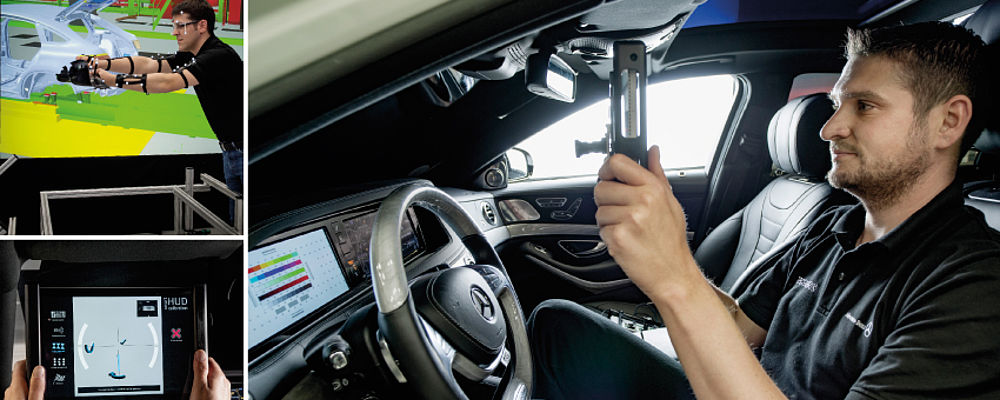
Change processes in the production area
Alongside drive train electrification and autonomous driving, it is above all digitalisation that is driving change in the automotive industry today. Mercedes-Benz interprets this to mean the digitalisation of the entire value chain, from design and development to production, and finally to sales and service. Markus Schäfer, Member of the Divisional Board of Mercedes-Benz Cars, Production and Supply Chain Management, puts it this way:
"For us at Daimler, there is no question that the digital revolution will fundamentally change our industry. This applies to the methods by which we develop, plan and produce our vehicles. It applies to the way we make contact with our customers. And not least, it can be experienced through our products themselves."
The potential is huge. Intelligently networking man, machine and industrial processes improves competitiveness by increasing flexibility and reducing costs. At the Sindelfingen plant it is already today extremely rare for two identical examples of the S-Class to leave the production lines. Innovation cycles are also getting shorter and shorter. And the changes continue. All this culminates in the vision of Mercedes-Benz that automobile production will change from large-scale to "one-off" production. Then every car will be built entirely to individual customer requirements.
According to that vision, the working world of the future will be characterised by human-robot cooperation (HRC). Humans will maintain control, in order to combine the cognitive superiority of humans with the power, endurance and reliability of the robots in an optimal way. At the same time, this will lead to higher quality, increased productivity and new possibilities for ergonomic and age-conformant work. The path forward to the Smart Factory with a completely networked value chain seems clear. Products, machines and the entire environment will then be networked with each other. Elements of this strategy include the efficient use of resources such as energy, buildings or material stocks as a decisive competitive factor. Completely digital process chains here also enable continuous inventory control, because components can be identified anywhere and at any time. Production facilities can be controlled from anywhere. Today the automaker is already able to digitally simulate the production process from the press plant to final assembly, and to master the complexity of modern automobiles and their manufacture. In the assembly of Mercedes-Benz vehicles, some 4,000 individual processes are examined for technical feasibility long before series production commences.
Suppliers must drive the digitalisation process
Change processes set in motion by the digital revolution concern not only production, but also the entire corporations. Automakers are becoming networked mobility services providers, and the employees also have to be on board. Michael Brecht, Chairman of the General Works Council of Daimler, says:
"Technical changes are coming. To shape these properly, we need a new humanisation policy. The decisive factor is how to design the relationship between autonomy and control in the man-machine interaction. Either: people will tell the machines what to do. Or: people will be told what to do by the machines. The key is to prepare people very well through qualification."
Such change processes do not leave supplier operations unaffected. Already today, automakers expect suppliers to join them along the course they have set. Take Audi, for example: when contacted, Sascha Höpfner, Spokesman Technology and Innovations at Audi, refers to the corporate procurement policy. It states that the goal of Audi AG is to select suppliers who meet the quality requirements of the company in all areas and who help to achieve the brand promise
"Vorsprung durch Technik" ( "Advancement through technology" ).
Since 2006, the procurement management of the entire Volkswagen Group has been based on the concept of sustainability in supplier relationships. Before submitting any quotation, suppliers must always declare active compliance with a so-called "Code of Conduct for Business Partners" Volkswagen Group requirements regarding sustainability in its relationships with business partners. Sustainability requirements also become part of the supplier agreement. Moreover, the Group as a whole requires the implementation of an early warning system to identify and minimise risks along the entire value chain. For verification purposes, a monitoring process documents the development of suppliers.
The Ingolstadt-based company expects its suppliers to take a clear stand and maintain an unequivocal attitude. Like other manufacturers, Audi also requires its suppliers to use an environmental management system, to avoid damage to health and the environment due to production operations, to respect employees’ freedom of association, not to tolerate discrimination and to exclude child and forced labour, as well as to comply with national statutory requirements and minimum standards relating to working hours and remuneration. At the same time, Audi expects its suppliers who act sustainably in this way to also require their own suppliers to comply with these same standards, thereby establishing uniform and consistent standards along the entire value chain. Since 2014, contracts include, in addition to the previously applicable environmental and social standards, a right to audit and a right to extraordinary termination in the event of violations. Closer attention is being paid to issues such as the fight against corruption, money laundering, import and export controls and unfair competition.
All manufacturers are continuing to develop relevant regulations. With the full digitalisation of the entire value chain, agreements concerning Corporate Social Responsibility will have to be supplemented by other comprehensive regulations.

